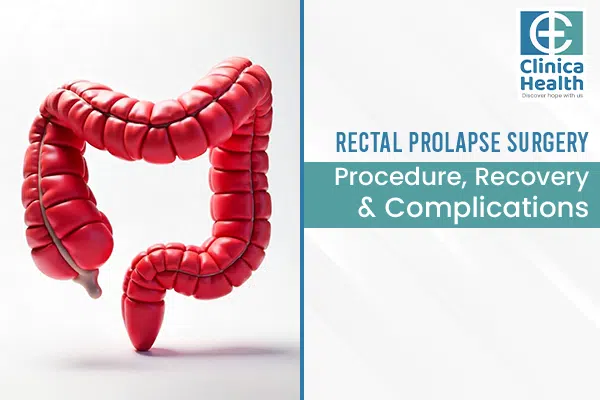-
 Call Now:
8010 552 552
7595 838 844
Call Now:
8010 552 552
7595 838 844
-
 Email Me:
[email protected]
Email Me:
[email protected]
Rectal prolapse happens when the rectum (the last section of the large intestine) loses its normal attachments, causing it to slide out through the anal orifice and turn inside out.
There are 3 types of prolapse that are referred to as “rectal prolapse”:
Rectal prolapse primarily affects adults; however, women over 50 are six times more likely than males to get it, says Dr. Purnendu Bhowmik, a famous rectal prolapse surgery specialist. It is humiliating and frequently has a negative impact on patients’ quality of life.
No. Rectal prolapse is caused by slipping of attachments of the final section of the large bowel. Haemorrhoids are enlarged blood vessels that form in the lower rectum and anus. Anal itching and soreness, irritation, and bright red blood on toilet tissue are all symptoms of haemorrhoids. Internal haemorrhoids that have slipped out of the anus (prolapsed) might make early rectal prolapse difficult to distinguish from internal haemorrhoids.
Rectal prolapse presents itself in a variety of ways. The sensation of a bulge or the appearance of a reddish-coloured mass that extends outside the anus is a sign of rectal prolapse. This is a transient condition that can occur during or after bowel movements. The extremity of the rectum may stretch out of the anal canal unexpectedly over time as a result of normal standing and walking and need to be forced back up into the anus by hand.
Rectal prolapse can also cause pain in the anus, as well as bleeding from the rectum’s inner lining. These symptoms are rarely life-threatening.Another symptom experienced is faecal incontinence.

Rectal prolapse is assumed to be caused by a variety of circumstances, although there is no definitive “cause.” According to the rectal prolapse doctor, chronic constipation (infrequent stools or intense straining) affects 30 percent to 67 percent of patients, while diarrhoea affects another 15%. Previously, it was thought that this disease was linked to multiple vaginal deliveries. However, up to 35% of people with rectal prolapse never gave birth, and it can affect men as well. Diabetes, chronic obstructive pulmonary disease, cystic fibrosis,hysterectomy and parasitic infections in the intestines can all induce rectal prolapse.
Your doctor will begin by taking your medical history and performing a rectal examination. To simulate a genuine bowel movement, you may be instructed to “strain” while sitting on a commode. Your doctor will be able to confirm the diagnosis and plan therapy if you can see the prolapse.
The following are some of the diagnostic tests:
Rectal prolapse treatment can begin at home in certain modest cases by using stool softeners and manually pushing the fallen tissue back up into the anus. However, in most cases, surgery is required to fix the prolapse.
There are a number of surgical treatment options. The surgeon’s decision is based on the patient’s age, other health issues, the amount of the prolapse, exam and other test results.
Rectal procedures are frequently performed in patients who are older or who have more health problems. The Altemeier and Delorme procedures are the two most prevalent rectal approaches:
Altemeier procedure: The section of the rectum protruding out of the anus is amputated and the two ends are sewed back together in the Altemeier surgery, also known as a perineal proctosigmoidectomy.
Delorme procedure: Only the inner surface of the falling rectum is removed in the Delorme operation. After that, the outside layer is folded and stitched, and the inside lining’s cut ends are stitched together.
The abdominal rectal prolapse repair involves making an opening in the abdominal muscles to examine and perform the operation on the abdominal cavity.
Rectopexy (rectum fixation by open or laparoscopic method) and resection (excision of a section of intestine), which is followed by rectopexy are the two most prevalent methods of abdominal repair.
Rectal prolapse treatment success varies depending on the state of the supporting tissues as well as the patient’s age and health. When compared to perineal treatments, abdominal surgeries have a lesser risk of the prolapse returning. Surgery usually resolves the prolapse in the majority of patients.

Was suffering from piles problem for long. Used to have bleeding during stool pass. Recently it became worse and the medicines were not working anymore. After a lot of research, chose Dr. Purnendu for laser piles surgery.

I was suffering from Grade III Haemorrhoids, Dr Purnendu has suggested surgery and after Surgery I am doing well. He is very kind hearted, and listened to patients problem very calmly and accordingly suggest the medication.

I was worried with my uncle’s piles problem for quiet a long time. Went through all those good reviews about Dr. Bhowmik and visited him. He made us comfortable from the very begining. Went ahead with the laser piles surgery…

Have you recently noticed a reddish lump around the anus? It might be a sign […]
Mon to Sat: 8 am – 5 pm, Sunday: CLOSED